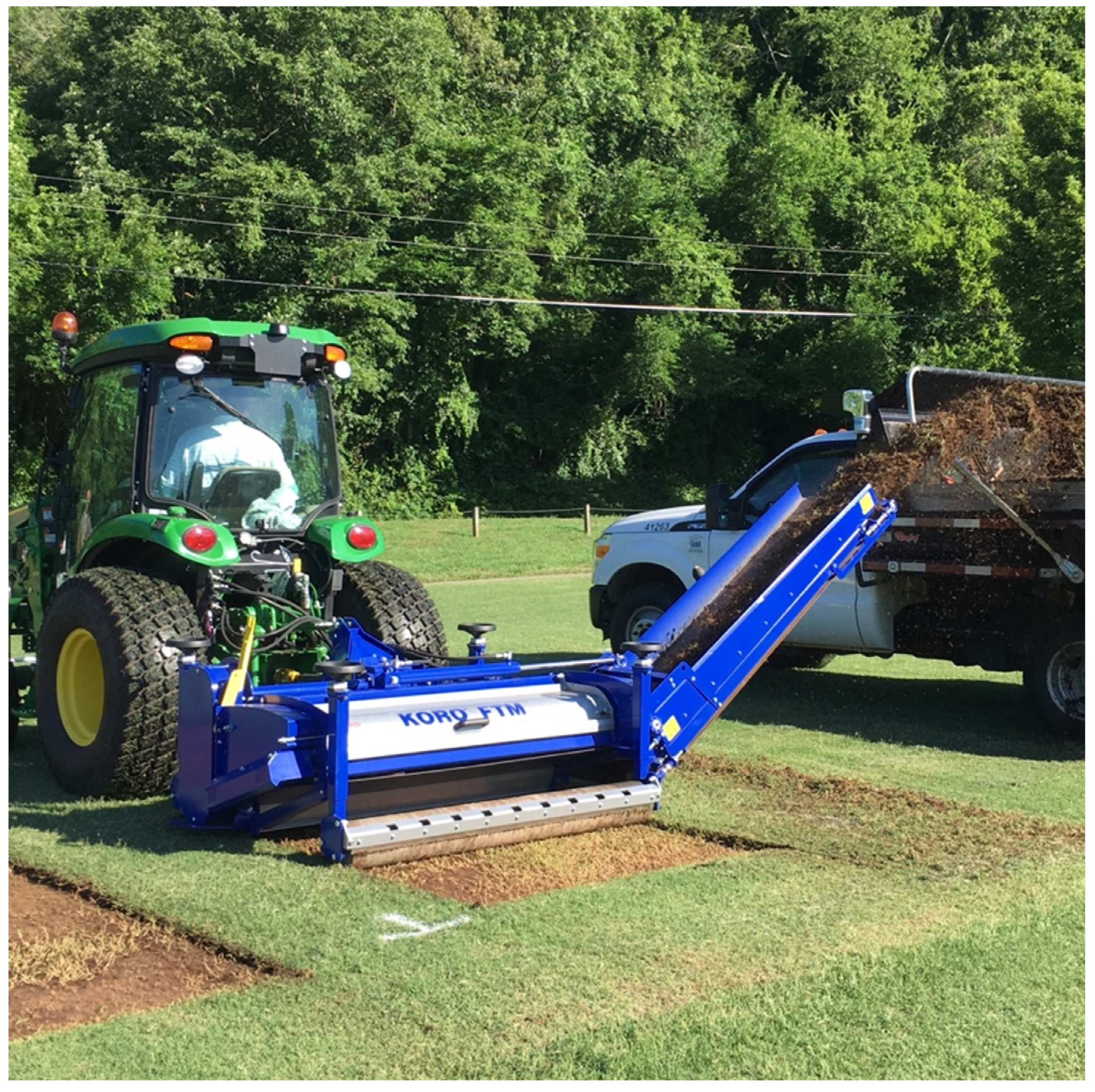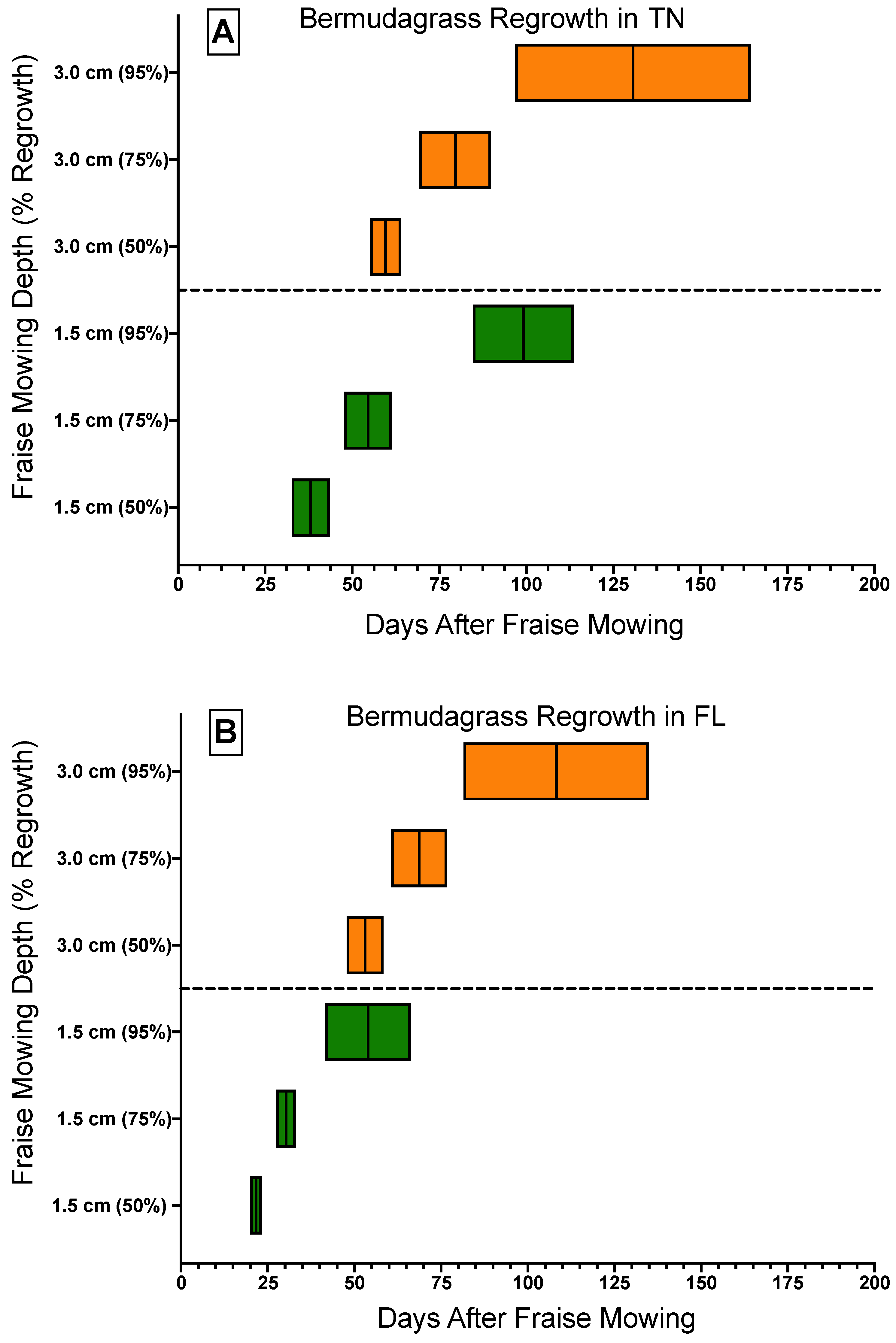Non-Chemical Control of Annual Bluegrass (Poa annua) in Bermudagrass (Cynodon spp.) via Fraise Mowing: Efficacy and Barriers to Adoption
Abstract
:1. Introduction
2. Materials and Methods
2.1. Field Assessment of Fraise Mowing Efficacy
2.1.1. Experimental Sites
2.1.2. Treatments and Experimental Design
2.1.3. Bermudagrass Regrowth
2.1.4. Annual Bluegrass Control
2.1.5. Statistical Analysis
2.2. Turfgrass Practitioner Perspectives
2.2.1. Research Approach
2.2.2. Data Collection
2.2.3. Data Analysis
3. Results
3.1. Bermudagrass Regrowth
3.2. Annual Bluegrass Control
3.3. Turfgrass Practitioner Perspectives
3.3.1. Benefits
3.3.2. Challenges
4. Discussion
Author Contributions
Funding
Institutional Review Board Statement
Informed Consent Statement
Data Availability Statement
Acknowledgments
Conflicts of Interest
References
- Milesi, C.; Running, S.W.; Elvidge, C.D.; Dietz, J.B.; Tuttle, B.T.; Nemani, R.R. Mapping and modeling the biogeochemical cycling of turf grasses in the United States. Environ. Manag. 2005, 36, 426–438. [Google Scholar] [CrossRef]
- United States Department of Agriculture. Crop Acreage Data 31 July 2020. 2020. Available online: https://www.fsa.usda.gov/news-room/efoia/electronic-reading-room/frequently-requested-information/crop-acreage-data/index (accessed on 27 April 2020).
- Haydu, J.J.; Hodges, A.W.; Hall, C.R. Economic Impacts of the Turfgrass and Lawncare Industry in the United States; FE632; University of Florida Institute of Food and Agricultural Sciences Extension: Gainesville, FL, USA, 2006; pp. 1–39. [Google Scholar]
- Stackhouse, T.; Martinez-Espinoza, A.D.; Emran Ali, M. Turfgrass disease diagnosis: Past, present, and future. Plants 2020, 9, 1544. [Google Scholar] [CrossRef]
- Soldat, D.J.; Brosnan, J.T.; Chandra, A.; Gaussoin, R.E.; Kowalewski, A.; Leinauer, B.; Rossi, F.S.; Stier, J.C.; Unruh, J.B. Estimating economic minimums of mowing, fertilizing, and irrigating turfgrass. Agric. Environ. Lett. 2020, e20032. [Google Scholar] [CrossRef]
- Brosnan, J.T.; Chandra, A.; Gaussoin, R.E.; Kowalewski, A.; Leinauer, B.; Rossi, F.S.; Soldat, D.J.; Stier, J.C.; Unruh, J.B. A justification for continued management of turfgrass during economic contraction. Agric. Environ. Lett. 2020, e20033. [Google Scholar] [CrossRef]
- Amani-Beni, M.; Zhang, B.; Xie, G.-D.; Xu, J. Impact of urban park’s tree, grass, and waterbody on microclimate in hot summer days: A case study of Olympic Park in Beijing, China. Urban For. Urban Green 2018, 32, 1–6. [Google Scholar] [CrossRef]
- Braun, R.C.; Bremer, D.J. Carbon sequestration in zoysiagrass turf under different irrigation and fertilization management regimes. Agrosyst. Geosci. Environ. 2019, 2, 180060. [Google Scholar] [CrossRef]
- Tanner, R.A.; Gange, A.C. Effects of golf courses on local biodiversity. Landsc. Urban Plan. 2005, 71, 137–146. [Google Scholar] [CrossRef]
- Nicholls, S.; Crompton, J.L. The impact of a golf course on residential property values. J. Sport Manag. 2007, 21, 555–570. [Google Scholar] [CrossRef]
- Brosnan, J.T.; Elmore, M.T.; Bagavathiannan, M.V. Herbicide-resistant weeds in turfgrass: Current status and emerging threats. Weed Technol. 2020, 34, 424–430. [Google Scholar] [CrossRef]
- Gadermaier, G.; Dedic, A.; Obermeyer, G.; Frank, S.; Himly, M.; Ferreira, F. Biology of weed pollen allergens. Curr. Allergy Asthma Rep. 2004, 4, 391–400. [Google Scholar] [CrossRef]
- Larsen, J.L.; Kesheimer, A.J.; Potter, D.A. Pollinator assemblages on dandelions and white clover in urban and suburban lawns. J. Insect Conserv. 2014, 18, 863–873. [Google Scholar] [CrossRef]
- Stewart-Wade, S.M.; Neumann, S.; Collins, L.L.; Boland, G.J. The biology of Canadian weeds. 177. Taraxacum officinale G.H. Weber ex Wiggers. Can. J. Plant Sci. 2002, 82, 825–853. [Google Scholar]
- Brosnan, J.T.; Dickson, K.H.; Sorochan, J.C.; Thoms, A.W.; Stier, J.C. Large crabgrass, white clover, and hybrid bermudagrass athletic field playing quality in response to simulated traffic. Crop Sci. 2014, 54, 1838–1843. [Google Scholar] [CrossRef]
- Rana, S.S.; Askew, S.D. Measuring canopy anamoly influence on golf putt kinematics: Does annual bluegrass influence bal roll behavior? Crop Sci. 2018, 58, 911–916. [Google Scholar] [CrossRef] [Green Version]
- Van Wychen, L. 2020 Survey of the Most Common and Troublesome Weeds in Grass Crops, Pasture and Turf in the United States and Canada. Weed Science Society of America National Weed Survey Dataset 2020. Available online: https://wssa.net/wssa/weed/surveys/ (accessed on 27 April 2020).
- Smiley, R.W.; Dernoeden, P.H.; Clarke, B.B. Compendium of Turfgrass Diseases, 3rd ed.; The American Phytopathological Society: Saint Paul, MN, USA, 2005. [Google Scholar]
- Inguagiato, J.C.; Martin, S.B. Disease of Cool- and Warm-Season Putting Greens; United States Golf Association Green Section Record: Liberty Corner, NJ, USA, 2015; Volume 53. [Google Scholar]
- Beard, J.B.; Olien, C.R. Low temperature injury in the lower portion of Poa annua L. crowns. Crop Sci. 1963, 3, 362–363. [Google Scholar] [CrossRef]
- Brosnan, J.T.; Breeden, G.K.; Zobel, J.M.; Patton, A.J.; Law, Q.D. Nonchemical annual bluegrass (Poa annua) management in zoysiagrass via fraise mowing. Weed Technol. 2020, 34, 482–488. [Google Scholar] [CrossRef] [Green Version]
- Ghanizadeh, H.; Mesarich, C.H.; Harrington, K.C. Molecular characteristics of the first case of haloxyfop-resistant Poa annua. Sci. Rep. 2020, 10, 4231. [Google Scholar] [CrossRef]
- Cross, R.B.; McCarty, L.B.; Tharayil, N.; Whitwell, T.; Bridges, W.C. Detecting annual bluegrass (Poa annua) resistance to ALS-inhibiting herbicides using a rapid diagnostic assay. Weed Sci. 2013, 61, 384–389. [Google Scholar] [CrossRef]
- McElroy, J.S.; Flessner, M.L.; Wang, Z.; Dane, F.; Walker, R.H.; Wehtje, G.R. A Trp574 to Leu amino acid substitution in the ALS gene of annual bluegrass (Poa annua) is associated with resistance to ALS-inhibiting herbicides. Weed Sci. 2013, 61, 21–25. [Google Scholar] [CrossRef]
- Lowe, D.B.; Swire-Clark, G.A.; McCarty, L.B.; Whitwell, T.; Baird, W.V. Biology and molecular analysis of dinitroaniline-resistant Poa annua L. Int. Turfgrass Soc. Res. J. 2001, 9, 1019–1025. [Google Scholar]
- Kelly, S.T.; Coats, G.E.; Luthe, D.S. Mode of resistance of triazine resistant annual bluegrass (Poa annua). Weed Technol. 1999, 13, 747–752. [Google Scholar] [CrossRef]
- Binkholder, K.N.; Fresenburg, B.S.; Teuton, T.C.; Xiong, X.; Smeda, R.J. Selection of glyphosate-resistant annual bluegrass (Poa annua L.) on a golf course. Weed Sci. 2011, 59, 286–289. [Google Scholar] [CrossRef]
- Brosnan, J.T.; Vargas, J.J.; Spesard, B.; Netzband, D.; Zobel, J.M.; Chen, J.; Patterson, E.L. Annual bluegrass (Poa annua) resistance to indaziflam applied early-postemergence. Pest Manag. Sci. 2020, 76, 2049–2057. [Google Scholar] [CrossRef]
- Heap, I. The International Herbicide-Resistant Weed Database 2021. Available online: http://weedscience.org/Pages/Species.aspx (accessed on 16 March 2021).
- Brosnan, J.T.; Vargas, J.J.; Breeden, G.K.; Zobel, J.M. Herbicide resistance in annual bluegrass on Tennessee golf courses. Crop Forage Turfgrass Manag. 2020, 6, e20050. [Google Scholar] [CrossRef]
- Norsworthy, J.K.; Ward, S.M.; Shaw, D.R.; Llewellyn, R.S.; Nichols, R.L.; Webster, T.M.; Bradley, K.W.; Frisvold, G.; Powles, S.B.; Burgos, N.R.; et al. Reducing the risks of herbicide resistance: Best management practices and recommendations. Weed Sci. 2012, 60, 31–62. [Google Scholar] [CrossRef] [Green Version]
- Watschke, T.L.; Long, F.W.; Duich, J.M. Control of Poa annua by suppression of seedheads with growth regulators. Weed Sci. 1979, 27, 224–231. [Google Scholar] [CrossRef]
- Lush, M. Biology of Poa annua in a temperate zone golf putting green (Agrostis stolonifera/Poa annua). II. The Seed Bank. J. Appl. Ecol. 1988, 25, 989–997. [Google Scholar] [CrossRef]
- Gaussoin, R.E.; Branham, B.E. Influence of cultural factors on species dominance in a mixed stand of annual bluegrass/creeping bentgrass. Crop Sci. 1989, 29, 480–484. [Google Scholar] [CrossRef]
- Bearss, R.C.; Rogers, N.J.; Crum, J.R.; Silcox, C.A. Fairway renovation with fraise mowing cultivation and dazoment fumigation. HortScience 2020, 55, 122–1227. [Google Scholar] [CrossRef]
- Miller, G.L.; Earlywine, D.T.; Fresenburg, B.S. Effect of fraze mowing on spring dead caused by Ophiosphaerella hepotricha of bermudagrass. Int. Turfgrass Soc. Res. J. 2017, 13, 225–228. [Google Scholar] [CrossRef]
- Richardson, M.D.; Brosnan, J.T.; McCalla, J.H.; Breeden, G.K. Fraise mowing can improve herbicidal control of bermudagrass. Int. Turfgrass Soc. Res. J. 2020. [Google Scholar] [CrossRef]
- Munshaw, G.C.; Dickson, K.H.; Cropper, K.L.; Sorochan, J.C. The effect of fraze mowing an overseed establishment in Cynodon dactylon turf. Int. Turfgrass Soc. Res. J. 2017, 13, 380–382. [Google Scholar] [CrossRef]
- Dickson, K.H.; Segars, C.A.; Sorochan, J.C.; Moss, J.Q.; Harris, D.; Strunk, W.D. Comparison of mechanical removal of perennial ryegrass overseeding out of bermudagrass to chemical transitions. Int. Turfgrass Soc. Res. J. 2020. [Google Scholar] [CrossRef]
- Baker, S.W.; Owen, A.G.; Woollacott, A.R. Physical and chemical control of Poa annua on professional football pitches. J. Turfgrass Sport Surf. Sci. 2005, 81, 47–61. [Google Scholar]
- McCauley, R.K.; Pinnix, G.D.; Miller, G.L. Fraise mowing as a spring transition aid. Crop Forage Turfgrass Manag. 2019, 5, 190025. [Google Scholar] [CrossRef]
- Lyman, G.T.; Throssell, C.S.; Johnson, M.E.; Stacey, G.A.; Brown, C.D. Golf course profile describes turfgrass, landscape, and environmental stewardship features. Appl. Turfgrass Sci. 2007, 4, 1–25. [Google Scholar] [CrossRef]
- Taylor, S.; Bogdan, R.; DeVault, M. Introduction to Qualitative Research, 4th ed.; John Wiley & Sons: Hoboken, NJ, USA, 2015. [Google Scholar]
- Dykstra, M.; Slute, B.; Wickens, A. Pesticide ban impacts: Three municipalities provide perspective. Sports Turfgrass Manag. 2010, 23, 20–24. [Google Scholar]
- Non-Essential Pesticide Prohibitions, Cosmetic Pesticide Use Restriction Bill; County Council for Montgomery County: Rockville, Maryland, 2019; pp. 52–14.
- Walsh, M.J.; Harrington, R.B.; Powles, S.B. Harrington seed destructor: A new nonchemical weed control tool for global grain crops. Crop Sci. 2012, 52, 1343–1347. [Google Scholar] [CrossRef]




| Percent Annual Bluegrass z | ||||
|---|---|---|---|---|
| Treatment y | January | February | March | April |
| Non-treated check | 33 a x | 38 a | 56 a | 62 a |
| Fraise mow 1.5 cm | 0 b | 1 b | 2 b | 2 b |
| Fraise mow 3.0 cm | 1 b | 2 b | 4 b | 2 b |
| Annual Bluegrass Plants z | ||||
|---|---|---|---|---|
| Treatment y | January | February | March | April |
| Non-treated check | 74 a x | 59 a | 26 a | 0 |
| Fraise mow 1.5 cm | 19 b | 42 a | 11 b | 0 |
| Fraise mow 3.0 cm | 16 b | 35 a | 9 b | 0 |
Publisher’s Note: MDPI stays neutral with regard to jurisdictional claims in published maps and institutional affiliations. |
© 2021 by the authors. Licensee MDPI, Basel, Switzerland. This article is an open access article distributed under the terms and conditions of the Creative Commons Attribution (CC BY) license (https://creativecommons.org/licenses/by/4.0/).
Share and Cite
Carroll, D.E.; Brosnan, J.T.; Unruh, J.B.; Stephens, C.A.; McKeithen, C.; Boeri, P.A. Non-Chemical Control of Annual Bluegrass (Poa annua) in Bermudagrass (Cynodon spp.) via Fraise Mowing: Efficacy and Barriers to Adoption. Sustainability 2021, 13, 8124. https://doi.org/10.3390/su13158124
Carroll DE, Brosnan JT, Unruh JB, Stephens CA, McKeithen C, Boeri PA. Non-Chemical Control of Annual Bluegrass (Poa annua) in Bermudagrass (Cynodon spp.) via Fraise Mowing: Efficacy and Barriers to Adoption. Sustainability. 2021; 13(15):8124. https://doi.org/10.3390/su13158124
Chicago/Turabian StyleCarroll, Devon E., James T. Brosnan, J. Bryan Unruh, Carrie A. Stephens, Chase McKeithen, and Pablo A. Boeri. 2021. "Non-Chemical Control of Annual Bluegrass (Poa annua) in Bermudagrass (Cynodon spp.) via Fraise Mowing: Efficacy and Barriers to Adoption" Sustainability 13, no. 15: 8124. https://doi.org/10.3390/su13158124
APA StyleCarroll, D. E., Brosnan, J. T., Unruh, J. B., Stephens, C. A., McKeithen, C., & Boeri, P. A. (2021). Non-Chemical Control of Annual Bluegrass (Poa annua) in Bermudagrass (Cynodon spp.) via Fraise Mowing: Efficacy and Barriers to Adoption. Sustainability, 13(15), 8124. https://doi.org/10.3390/su13158124






